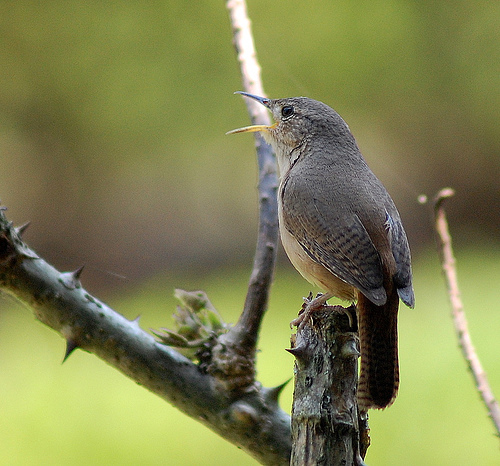- Troglodytes (wren)
__NOTOC__Taxobox
name = "Troglodytes"

image_width = 220px
image_caption = SouthernHouse Wren inSão Paulo Botanic Garden (Brazil ) It is sometimes considered a distinct species, "Troglodytes musculus"
regnum =Animalia
phylum =Chordata
classis =Aves
subclassis =Neornithes
infraclassis =Neognathae
superordo =Neoaves
ordo =Passeriformes
subordo =Passeri
infraordo =Passerida
familia =Troglodytidae
genus = " Troglodytes "
genus_authority = Vieillot,1809
subdivision_ranks =Species
subdivision = About one dozen, see text."Troglodytes" [
Etymology :Ancient Greek τρωγλοδύτες "cave-dwellers" (comparetroglodyte ), from "trogle" (τρώγλη) "hole" + "dyein" (δυειν) "to enter". In reference to the tendency of these wrens to enter small crevices as they search for food.] is a genus of smallpasserine bird s in thewren family.These wrens are around 11 or 12 cm long. They are typically streaked brown above and somewhat paler below, with short rounded wings, strong legs and a cocked tail. The flight is direct and buzzing."Troglodytes" wrens are mostly found in somewhat cooler habitats than most of their relatives. Most of the species are found in the mountains from
Mexico to northernSouth America . Three species are found in temperate latitudes: TheHouse Wren occurs widely in both tropical and temperate lowlands. The hardyWinter Wren has a wide distribution inNorth America ,Europe andAsia and is the only wren of any genus which occurs outside theNew World . TheCobb's Wren of theFalkland Islands is another species which tolerates harsh conditions well.Like other wrens, they are elusive as they hunt for small
insect s andspider s, but they readily reveal their positions through their loud songs.These are territorial birds, but the tiny Winter Wren will roost communally in a cavity in cold weather to help conserve heat.
ystematics and species
The closest living relatives of this genus are possibly the
Timberline Wren and the "Cistothorus " species rather than the "Henicorhina " wood-wrens as is sometimes proposed.A number of the "Troglodytes" species, such as the Clarion Wren, were formerly considered subspecies of the House Wren, and it has been argued that at least the tropical forms of the House Wren should be further split as the Southern House Wren, "Troglodytes musculus" [noted in Howell & Webb (1995)] . The Socorro Wren, in older times placed into "Thryomanes" (
Bewick's Wren ), is actually a close relative of the House Wren complex, as indicated by "manners, song, plumage, etc" [Howell & Webb (1995)] and bybiogeography andmtDNA NADH dehydrogenase subunit 2 sequence analysisMartínez Gómez "et al." (2005)] .The Winter Wren is less closely related to the other members of the genus, and is occasionally split as the
monotypic genus "Nannus"Fact|date=February 2007. It might actually be closely related to "Cistothorus", but again, the molecular data is insufficient to properly resolve this issue.pecies
*
House Wren , "Troglodytes aedon" - taxonomy needs revision
** Northern House Wren, "Troglodytes (aedon) aedon" group
**Brown-throated Wren , "Troglodytes (aedon) brunneicollis" group
** Southern House Wren, "Troglodytes (aedon) musculus" group
** Cozumel Wren, "Troglodytes (aedon) beani"
** Guadeloupe Wren, "Troglodytes aedon guadeloupensis" - taxonomic status unresolved; possiblyextinct (late 20th century)
** Martinique Wren, "Troglodytes aedon martinicensis" - taxonomic status unresolved; possiblyextinct (c.1890)
*Clarion Wren , "Troglodytes tanneri" - formerly included in "T. aedon"
*Socorro Wren , "Troglodytes sissonii" - formerly included in "T. aedon"
*Cobb's Wren , "Troglodytes cobbi" - formerly included in "T. aedon"
*Rufous-browed Wren , "Troglodytes rufociliatus"
*Tepui Wren , "Troglodytes rufulus"
*Mountain Wren , "Troglodytes solstitialis"
*Ochraceous Wren , "Troglodytes ochraceus"
*Santa Marta Wren , "Troglodytes monticola"
*Winter Wren , "Troglodytes troglodytes" - possibly belongs in monotypic genus "Nannus"
**Daito Winter Wren , "Troglodytes troglodytes orii" - validity doubtful;extinct (c.1940)Even with the help of the most recent molecular data the relationships of the species could not be fully resolved however. There appear to be 2
clade s, one comprising the house wren group and another containing Central and South American species. The relationships of the Rufous-browed andBrown-throated Wren s are indeterminable with the present molecular data; they appear fairly basal and the former might be closer to the house wren group than the latter. TheSanta Marta Wren is quite enigmatic and little-studied.Footnotes
References
* (1991): "A guide to the birds of Trinidad and Tobago" (2nd edition). Comstock Publishing, Ithaca, N.Y.. ISBN 0-8014-9792-2
* (2003): "Birds of Venezuela". Christopher Helm, London. ISBN 0-7136-6418-5
* (1995): "A Guide to the Birds of Mexico and Northern Central America". Oxford University Press, Oxford & New York. ISBN 0-19-854012-4
* (2005): Phylogenetic position and generic placement of the Socorro Wren ("Thryomanes sissonii"). "Auk" 122(1): 50–56. [English with Spanish abstract] DOI:10.1642/0004-8038(2005)122 [0050:PPAGPO] 2.0.CO;2 [http://www.specifysoftware.org/Informatics/bios/biostownpeterson/MBP_A_2005.pdf PDF fulltext]
* (2002): "Field Guide to the Birds of North America". National Geographic, Washington DC. ISBN 0-792-26877-6
* aut|Rice, Peterson and Escalona-Segura: "Phylogenetic patterns in montane "Troglodytes" wrens"
* (1989): "A guide to the birds of Costa Rica". Comistock, Ithaca. ISBN 0-8014-9600-4
* (1999): "Collins bird guide". Harper & Collins, London. ISBN 0-00-219728-6
Wikimedia Foundation. 2010.
